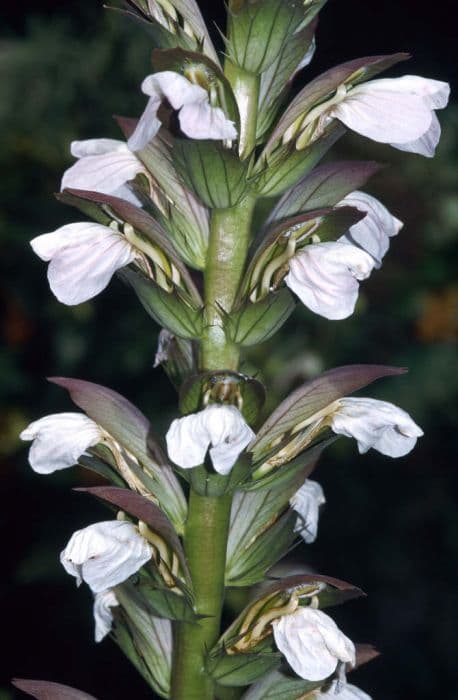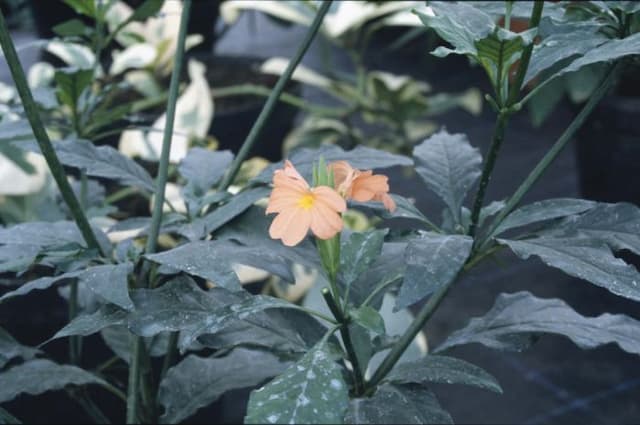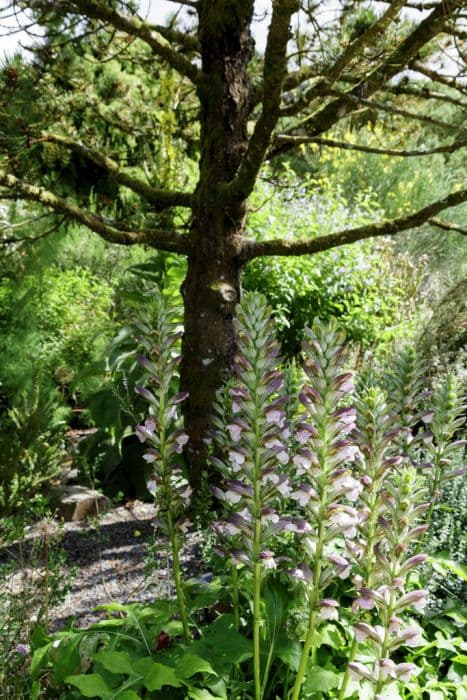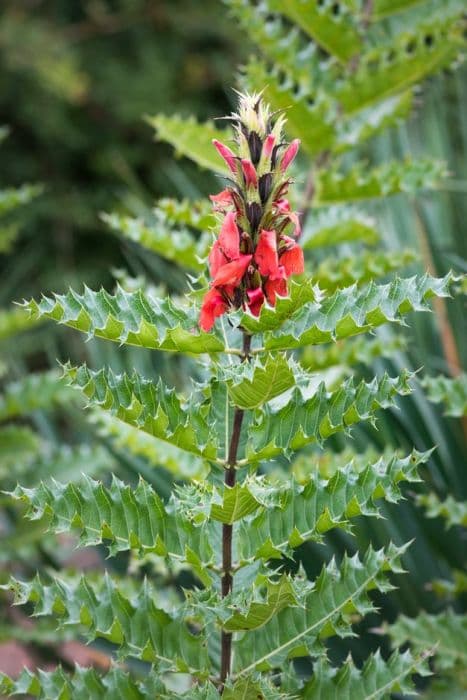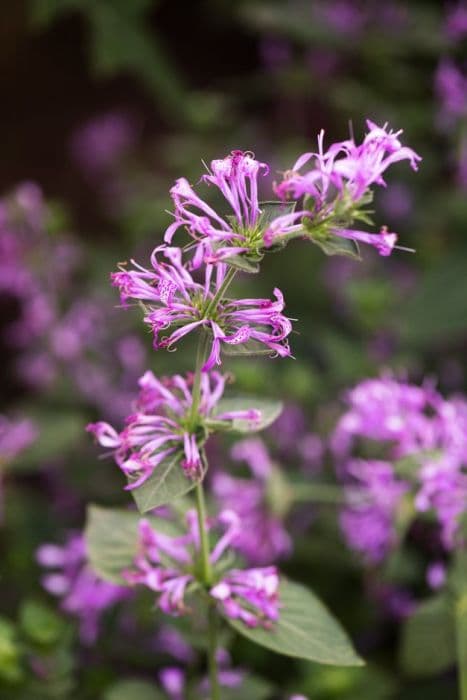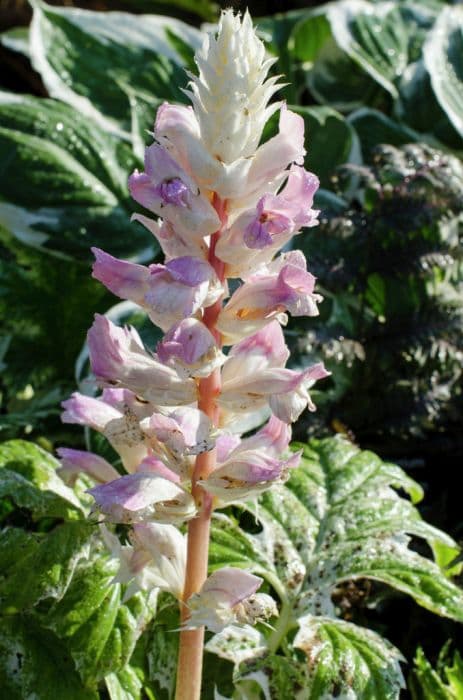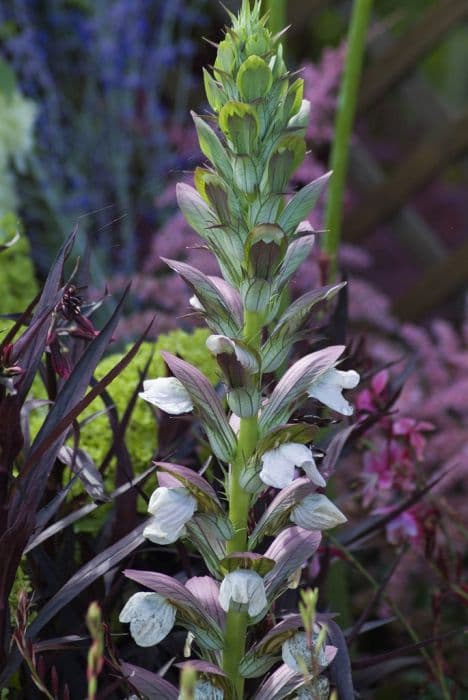Bear's breeches Acanthus hirsutus

ABOUT
Acanthus hirsutus, commonly known as the Hairy Acanthus, is a plant with a distinctive and robust appearance. The leaves of the Hairy Acanthus are large, deeply lobed, and have a textured surface which gives the plant its 'hairy' common name. These leaves typically boast a dark green hue that can appear almost glossy in sunlight. The flowers of the Hairy Acanthus are equally striking, emerging on long spikes above the foliage. Each spike includes numerous blossoms, which are shaped like tubular bells or elongated trumpets. These flowers are generally white or pale pink, often marked with purplish or mauve streaks or spots, adding contrast and visual interest. Furthermore, the plant's overall form is quite architectural with its bold leaves and erect flower spikes, which can add vertical interest to a garden setting. Their overall aesthetic is one of lush and dramatic foliage complemented by striking floral displays that can provide a focal point in landscaping designs. Despite their rugged look, these plants can blend well into various garden themes, including those with a Mediterranean or tropical feel.
About this plant
 Names
NamesFamily
Acanthaceae
Synonyms
Hairy Acanthus, Bristly Acanthus, Sea Dock, Sea Holly, Bear's Breech, Oyster Plant
Common names
Acanthus balcanicus, Acanthus longifolius, Acanthus spinosissimus.
 Toxicity
ToxicityTo humans
Acanthus hirsutus, commonly known as the bristly bear's breech, is not widely recognized for being toxic to humans. However, it is always advisable to exercise caution with plants that are not commonly consumed, as individual sensitivities and allergic reactions could occur. Ingestion of parts of the plant that are not meant for consumption might lead to gastrointestinal discomfort or other non-specific symptoms. As with any plant, it is best to keep it out of the reach of children who might inadvertently ingest it.
To pets
Bristly bear's breech is not specifically documented for its toxicity to pets. However, like with humans, it's prudent to prevent pets from ingesting the plant as it may potentially cause gastrointestinal upset or other digestive issues. Symptoms of poisoning in pets may be similar to those in humans – including vomiting, diarrhea, or drooling. If a pet is suspected of ingesting any part of the plant and exhibits these symptoms or any other changes in behavior, it is important to consult a veterinarian.
 Characteristics
CharacteristicsLife cycle
Perennials
Foliage type
Semi-deciduous
Color of leaves
Green
Flower color
White
Height
3 feet (0.91 meters)
Spread
2 feet (0.61 meters)
Plant type
Herb
Hardiness zones
8
Native area
Mediterranean
Benefits
 General Benefits
General Benefits- Landscape Aesthetics - Acanthus hirsutus, commonly known as the bear's breech, has showy flowers and large, glossy leaves, making it an attractive addition to gardens and landscaped areas.
- Pollinator Attraction - The flowers of Acanthus hirsutus can attract bees and other pollinating insects, promoting biodiversity in the garden.
- Drought Tolerance - Bear's breech is known for its ability to withstand dry conditions once established, making it a robust choice for water-conservation landscapes.
- Architectural Interest - With its tall flower spikes and striking foliage, bear's breech can add a structure to garden designs or be used as a focal point in plantings.
- Erosion Control - The root system of Acanthus hirsutus can help stabilize soil and prevent erosion on slopes or in areas prone to soil degradation.
- Low Maintenance - Bear's breech is generally low maintenance, requiring minimal care once established, apart from occasional watering and the removal of spent flowers.
- Deer Resistance - The plant is often considered deer resistant, which makes it suitable for areas where deer browsing is a problem for gardeners.
- Seasonal Interest - Acanthus hirsutus provides seasonal interest through its summer blooming period and the enduring structure of its leaves throughout the year.
 Medical Properties
Medical Properties- Anti-inflammatory: Acanthus hirsutus has been traditionally used to reduce inflammation.
- Wound healing: The plant has been applied in the past for its purported properties in aiding the healing of wounds.
- Antimicrobial: There is some evidence that Acanthus hirsutus may possess antimicrobial properties, helping to prevent the growth of certain bacteria and fungi.
 Air-purifying Qualities
Air-purifying QualitiesThis plant is not specifically known for air purifying qualities.
 Other Uses
Other Uses- Acanthus hirsutus, commonly known as the Bear's Breech, can be used as a decorative element in plasterwork or wood carvings due to its striking foliage, which has been a common motif in classical architecture and design.
- Its robust nature allows it to be planted for erosion control, especially in areas with poor soils where other plants might struggle to establish.
- The long and sturdy flowering stalks of the Bear's Breech can be dried and used in floral arrangements or as part of craft projects for their structural interest.
- The spiky leaves have been historically used as a model in teaching the art of botanical illustration, due to their complex and detailed structure.
- Due to its dense growth, Bear's Breech is sometimes utilized as a natural screening plant in gardens to provide privacy or block out unsightly views.
- The plant's leaves have been used as a natural template or stencil in various art projects, including fabric printing and decorative wall painting.
- In addition to ornamentation, the leaves and flowers can be used in educational settings as a tool for studying plant morphology and reproductive strategies among various plant species.
- The seeds of Acanthus hirsutus can be collected and used for crafting unique jewelry items, such as pendants and earrings, after proper treatment and preparation.
- Gardeners may incorporate Bear's Breech in companion planting schemes to create textural contrast and support biodiversity in the garden ecosystem.
- Sometimes used in the recreation of historical gardens or restoration projects, the Bear's Breech can contribute to an authentic atmosphere, reflecting its traditional role in garden designs of the past.
Interesting Facts
 Feng Shui
Feng ShuiThe Bear's breech is not used in Feng Shui practice.
 Zodiac Sign Compitability
Zodiac Sign CompitabilityThe Bear's breech is not used in astrology practice.
 Plant Symbolism
Plant Symbolism- Artistic Inspiration: The Acanthus plant has been a long-standing motif in classical architecture and art, symbolizing an aesthetic and creative spirit.
- Endurance and Perseverance: With its ability to thrive in challenging conditions, Acanthus hirsutus represents resilience and the capacity to endure hardships.
- Healing: Historically, parts of this plant were used for their medicinal properties, so they can also symbolize health and healing.
- Heavenly Connection: The Acanthus' leaves are reminiscent of Corinthian columns, which are often connected to grand and religious structures, symbolizing a bridge between the earth and the heavens.
 Water
WaterThe best watering approach for the Bear's Breech is to maintain a consistent moisture level in the soil, especially during the active growing season. They should be watered deeply, but allow the soil to dry out slightly between waterings to prevent root rot. As a rough guide, watering once a week with about 1.5 gallons of water should be sufficient, but this can vary depending on the climate and soil conditions. During hot and dry periods, the frequency may need to increase, whereas in cooler or rainy seasons, it should decrease.
 Light
LightBear's Breech thrives in full sun to partial shade conditions. It prefers a spot that receives at least 4 to 6 hours of sunlight per day, but it can also tolerate some shade, especially in the afternoon in hot climates. The ideal location offers morning sunlight with dappled or partial shade in the afternoon to protect the foliage from intense heat.
 Temperature
TemperatureBear's Breech does well in a wide range of temperatures but prefers a climate that stays between 50°F and 80°F. It can survive in temperatures as low as 15°F, making it suitable for many temperate regions. For optimal growth and flowering, maintain an environment where the plant is not exposed to extreme heat above 90°F for prolonged periods.
 Pruning
PruningPruning Bear's Breech is mainly for aesthetic purposes and to remove spent flower spikes to encourage a tidy appearance and potentially additional blooms. It should be done after the plant finishes flowering, usually in late summer or fall. Remove the flower stalks at their base, and also cut back any damaged or yellowing leaves. Pruning can be done annually, and while the plant is dormant in winter, any additional shaping or size control can be addressed.
 Cleaning
CleaningAs needed
 Soil
SoilThe Bear's Breeches prefers well-draining soil enriched with organic matter. A suitable soil mix can be made using two parts garden soil, one part peat or compost, and one part perlite or sand to improve drainage. The ideal soil pH for Bear's Breeches should be slightly acidic to neutral, around pH 6.0 to 7.5.
 Repotting
RepottingBear's Breeches should be repotted every two to three years or when it becomes root-bound. The best time to repot is in the spring or early summer to allow the plant to establish in the growing season.
 Humidity & Misting
Humidity & MistingBear's Breeches thrives in average room humidity levels. It does not require any special humidity adjustments, making it relatively easy to care for in most indoor environments.
 Suitable locations
Suitable locationsIndoor
Provide bright, indirect light and room humidity.
Outdoor
Plant in partial shade, enrich soil, provide space to spread.
Hardiness zone
7-10 USDA
 Life cycle
Life cycleAcanthus hirsutus, more commonly known as the bristly acanthus, begins its life cycle as a seed, which germinates in warm and moist soil conditions, typically in spring. Upon germination, the seedling emerges and develops its first set of true leaves, transitioning into the vegetative growth stage during which it forms a rosette of large, spiny leaves. The plant will then enter a period of maturation, wherein it may remain in a vegetative state for one or more years, given that it is a perennial. When it reaches maturity, usually in late spring to early summer, Acanthus hirsutus produces tall flowering spikes with white or light purple flowers, each surrounded by spiny bracts. After flowering, the plant sets seed, which are dispersed by the wind or animal activity, ensuring the propagation of the next generation. The plant may die back to the root system in colder climates during winter, to regrow in the following spring, or remain evergreen in milder conditions.
 Propogation
PropogationPropogation time
Spring
Propogation: The best time to propagate Bear's Breech, or Acanthus hirsutus, is typically in spring or early summer when the weather starts to warm. The most popular method of propagation for Bear's Breech is by seed. To propagate by seed, collect seeds from ripe seed pods of an existing plant, and sow them directly into a well-draining soil mix in a pot or seed tray. Place the pot or tray in a warm, bright location, but not in direct sunlight. Keep the soil moist but not waterlogged. Germination can take several weeks, and once the seedlings have developed their first true set of leaves, they can be transplanted into individual pots or directly into the garden if outdoor conditions permit. Ensure that the seedlings are well-acclimatized before transplanting to avoid shock from changing conditions.
